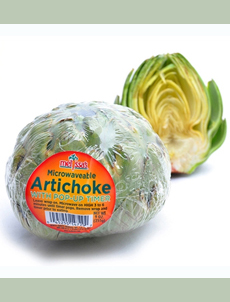TIP: How To Microwave Artichokes
|
The globe artichoke (Cynara cardunculus var. scolymus) is a species of thistle cultivated as a vegetable. It is actually a flower head, a cluster of numerous immature buds of what would be a blossom if not picked before it bloomed. The cardoon (Cynara cardunculus) is a wild variant available in spring.
The artichoke stem is also delicious. It is an extension of the artichoke heart. The thistle family is a group of flowering plants that have leaves with sharp prickles. They, along with the inner choke (more about that in a bit), make eating whole artichokes a labor of love, like eating a whole lobster. But like that lobster, what’s inside is more than worth it. Native to the Mediterranean, the artichoke was popular with the ancient Greeks and Romans. The Greeks called them kaktos and the Romans called them carduus. The English word evolved from the medieval Arabic al-khurshuf, which evolved into alcachofa in Arabic, alcachofa in Spanish, carciofo in Italian, artichaut in French and Artischocke in German. Artichoke cultivation spread to Italy and southern France in the late 15th and early 16th centuries. The original artichokes were small, the size of hens’ eggs. Breeding created the globe. |
An artichoke in bloom in Montpellier, France. One the flower blooms, the flesh becomes coarse and barely edible. Photo by Alvesgaspar | Wikimedia. |
|
|
The Dutch introduced artichokes to England, and they were grown in Henry VIII’s garden by 1530. They arrived in the U.S. in the 19th century, brought to Louisiana by French immigrants and to California by Spanish immigrants. [Source] March 16th is National Artichoke Hearts Day. And now, let’s eat! Microwaving is much faster than conventional steaming on the stove top. Prep time is 3 minutes, cook time is 7 minutes. While freshly-harvested artichokes are sweet, some cooks add a drizzle of lemon juice before cooking to eliminate any bitterness. (We’ve never had a bitterness problem.) Ingredients |
||
|
|
Preparation 1. RINSE the artichokes, not just to clean them but to provide moisture for microwaving. Tear off any tiny lower leaves or leaves that are blemished. 2. TRIM any leaves from the stem. You can leave the stem on, or cut it off at the base of the globe and cook it next to it. (NOTE: Some supermarket artichokes have already been trimmed of the stem.) 3. USING a scissors, slice off the prickly tips of the leaves. Our mother, ever the creative kitchen artist, used a pinking shears to create a decorative edge. Drizzle a tablespoon of lemon juice into the wells of the leaves. 4. PLACE the artichoke in a microwave safe dish with 1/4 inch of water in the bottom, and over tightly with plastic wrap. Alternatively, you can cook them in a dish with a tight cover that keeps in the steam. Microwave on high for 7 minutes for one artichoke; 10 minutes for two; 15 minutes for four; 19 minutes for six. 5. CHECK for done-ness by removing a leaf from the center of the leaves. If it pulls out easily, the artichokes are done. If not done, continue to cook at 30-second intervals. After you try this technique, you’ll know what works for your microwave. |
|
|
6. PLATE and serve. While we love eating them plain, perhaps with a squeeze of fresh lemon or lime juice, others like to dip the artichokes in melted butter or another dip such as aïoli (garlic mayonnaise), rouille (red pepper aïoli), romesco sauce, yogurt dip with your favorite herbs or spices (dill or cumin are popular) or vinaigrette (try this green olive vinaigrette). You can serve steamed artichokes warm/hot, at room temperature or chilled. HOW TO EAT AN ARTICHOKE We look for artichokes with the fewest blemishes and the longest stems. As with any produce, don’t buy more than you will use in a few days. Keep them in the fridge until you’re ready to cook them. How about a recipe for artichoke hearts-stuffed baked potato?
|
||




